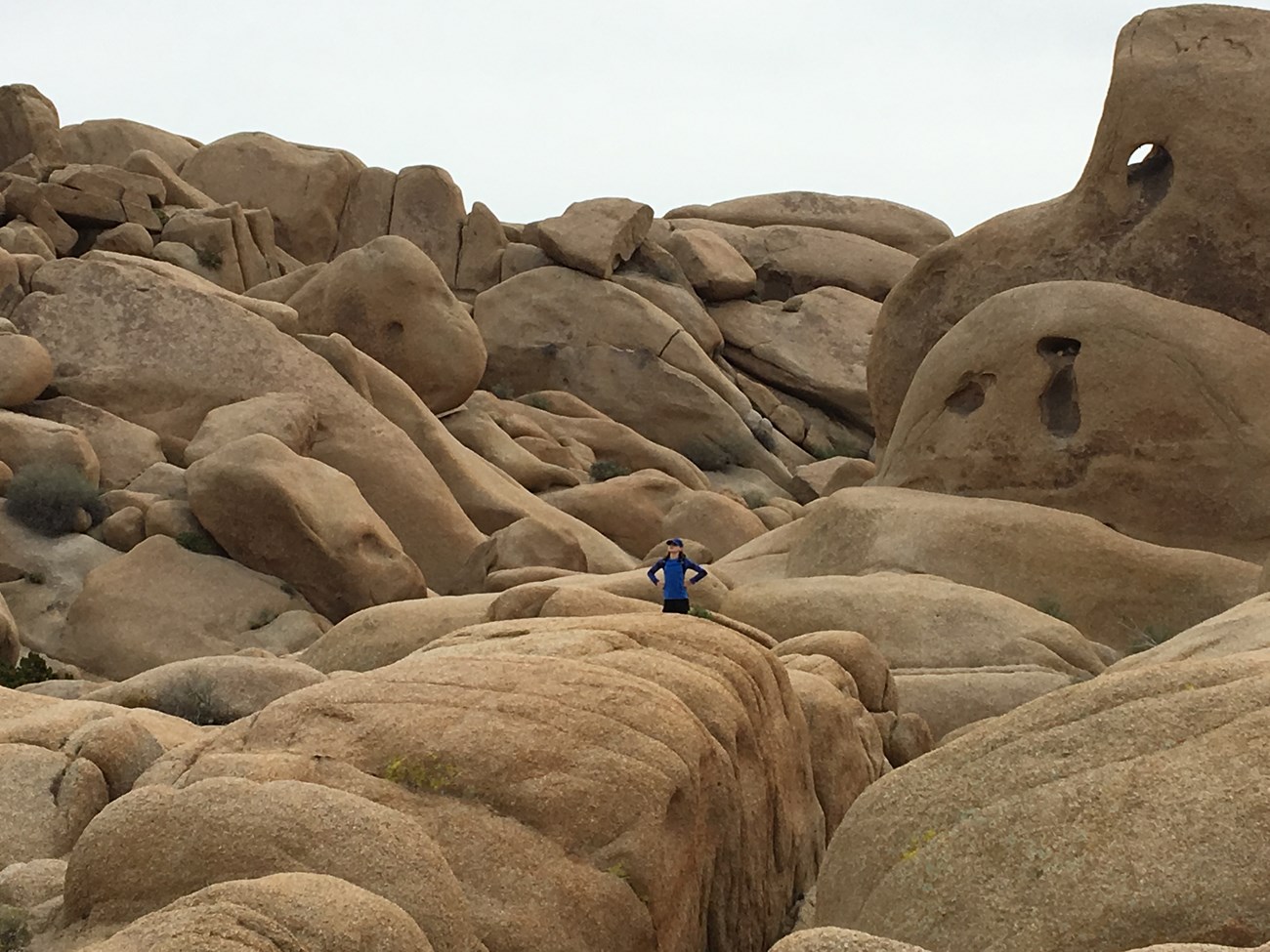
Introduction
Igneous rocks are “fire-born,” meaning that they are formed from the cooling and solidification of molten (melted) rock. The word igneous derives from ignis, the Latin word for “fire.” Molten rock material is known as magma until it is erupted onto the surface when it then is termed lava.
There are two broad types of igneous rocks:
-
Intrusive (plutonic) rocks
- Extrusive (volcanic) rocks
Intrusive (Plutonic) Rocks
Intrusive igneous rocks solidify within Earth. These rocks are also known as plutonic rocks—named for Pluto, the Roman god of the underworld. Intrusive igneous rocks are generally wholly crystalline and characterized by large crystal sizes visible to the naked eye because they cool slowly.
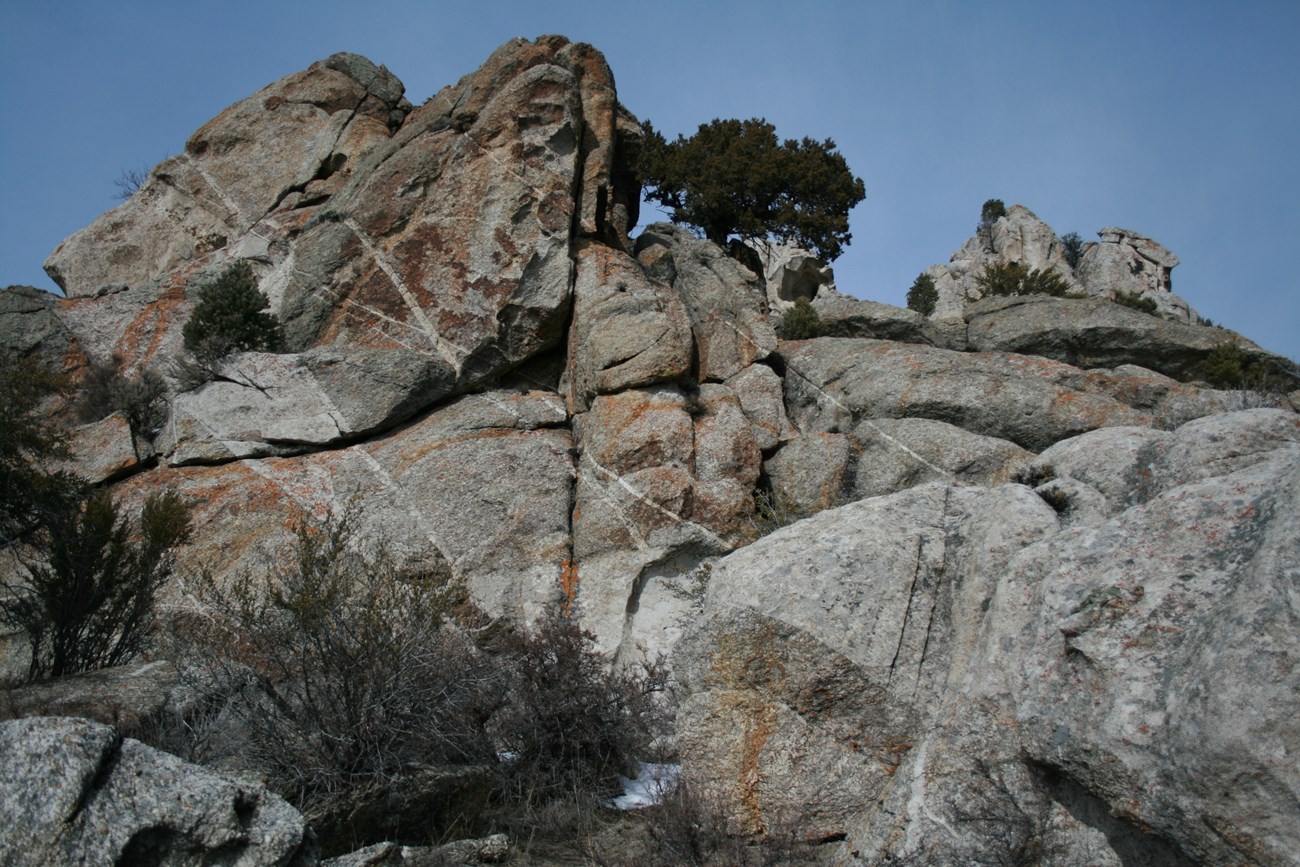
NPS photo.
Featured Video—Yosemite Granite
-
Yosemite Nature Notes 20: Granite
Many national parks were founded for their geology, and Yosemite is known throughout the world for its exceptional high cliffs and rounded domes. Visitors to the park, from hikers to rock climbers, experience a landscape dominated by granite.
- Duration:
- 7 minutes, 11 seconds
Extrusive (Volcanic) Rocks
Extrusive igneous rocks are erupted onto the surface or into the atmosphere. Extrusive igneous rocks are also termed volcanic rocks—named for Vulcan, the Roman god of fire. Volcanic rocks have generally smaller crystal size and usually have a very-fine-grained or glassy groundmass that formed due to rapid cooling at the time of eruption.
Volcanic rocks are erupted as lava flows or lava domes during nonexplosive (effusive) eruptions or as shattered bits of rock (volcanic ash, tephra, and volcanic bombs which are collectively called pyroclasts) during explosive eruptions. Pyroclastic rocks are made of volcanic ash and other pieces of pulverized volcanic rock. The term pyroclastic means “fire-broken” from “pryo-” (fire) and “-clastic” (broken) in Greek. Pyroclastic rocks include ash-fall and tephra-fall deposits as well as ash-flow tuffs (ignimbrites) that form from pyroclastic density currents.
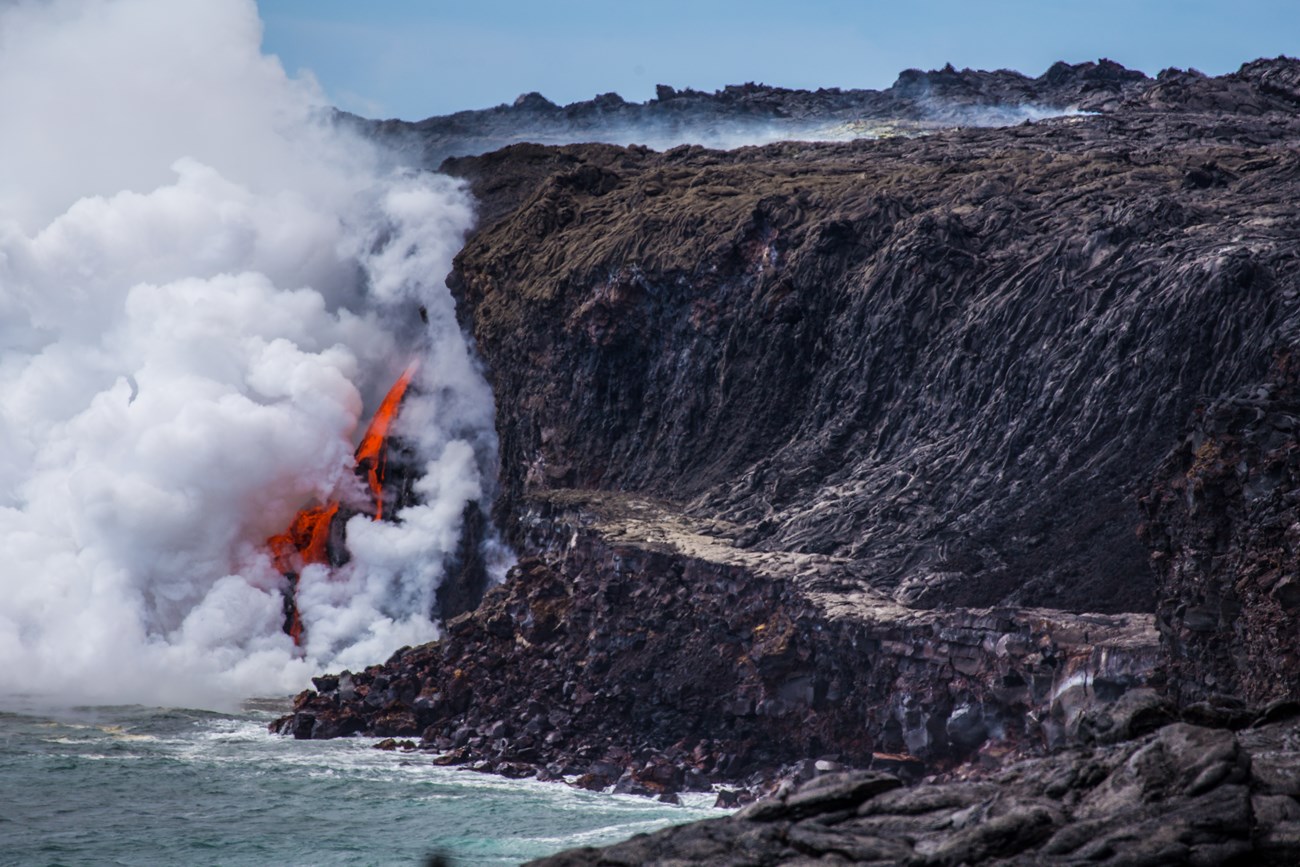
Related Links
Classification of Igneous Rocks
Igneous rocks are classified both by their chemical composition, mineral composition, texture, and structure.
Texture and structure refer to the relationships between crystals, groundmass, vesicles, and other components of a rock.
Composition and Minerals
Igneous rocks are mostly made of the most common elements found in the Earth’s crust. In descending order, they are:
-
Oxygen (0)
-
Silicon (Si)
-
Aluminum (Al)
-
Iron (Fe)
-
Calcium (Ca)
-
Sodium (Na)
-
Magnesium (Mg)
-
Potassium (K)
Almost all igneous rocks are silicates meaning that silicon and oxygen are the two most common elements in them. Composition of igneous rocks is expressed as weight percent silica, which ranges from about 45 to 78 (wt % SiO2). Low silica rocks have higher concentrations of iron and magnesium. In turn, high silica rocks have less iron and magnesium, and more sodium and potassium.
The two major divisions of igneous rocks based on composition are:
-
Mafic - high in magnesium and iron (and low in silica)
-
Silicic - high in silica (and low in magnesium and iron)
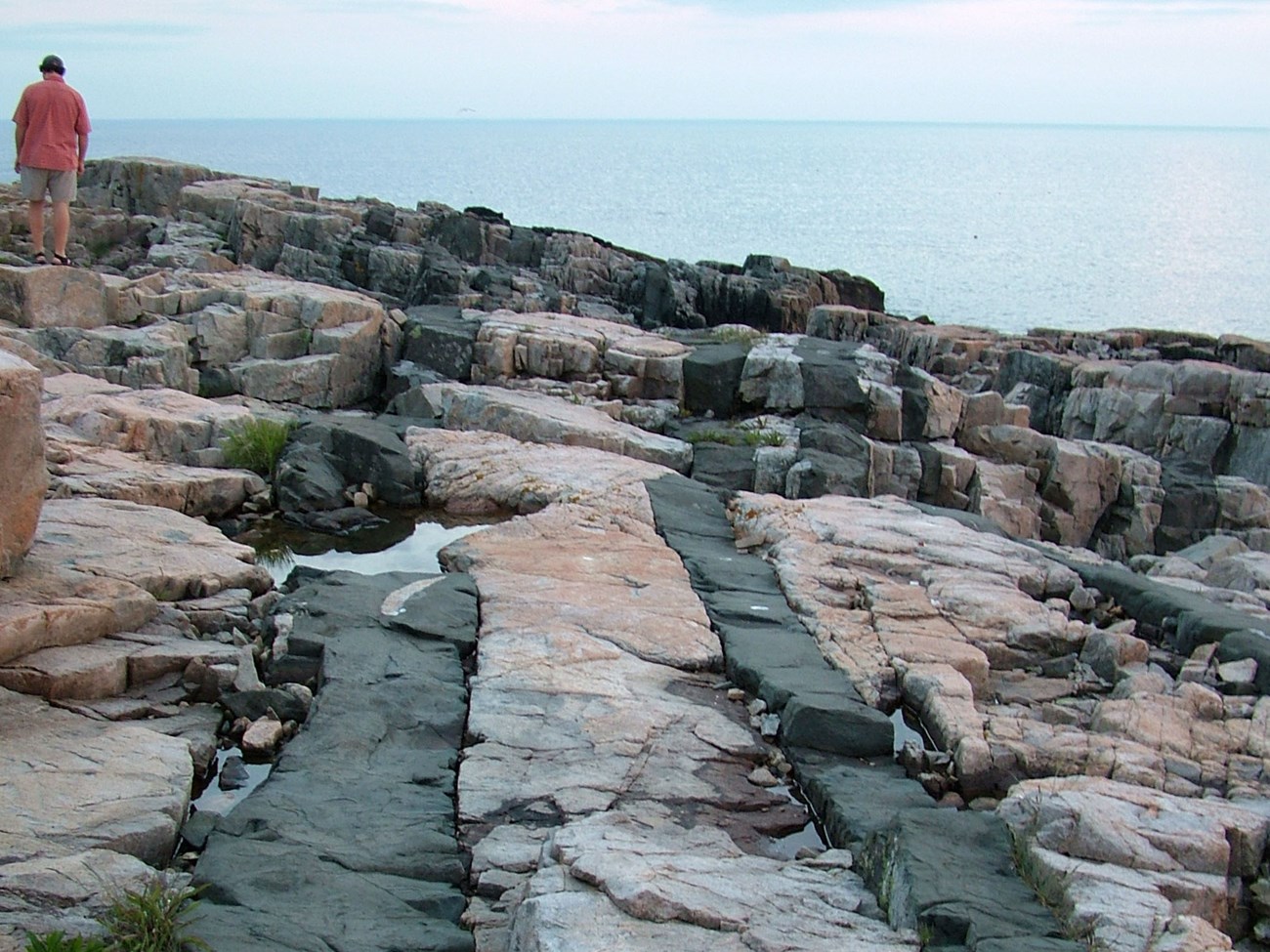
NPS photo by Georgia Hybels.
Intermediate rocks are those that have compositions between mafic and silicic.
|
Mafic |
Intermediate |
Silicic |
|
|
Intrusive (Plutonic) |
Gabbro |
Diorite |
Granite |
|
Extrusive (Volcanic) |
Basalt |
Andesite |
Rhyolite |
Rock types have been defined for rocks that have compositions in between the six shown in the chart above. For example, the intrusive rock granodiorite has a composition between diorite and granite. The volcanic basaltic andesite has a composition between basalt and andesite. Dacite and rhyodacite are in between andesite and rhyolite, with rhyodacite having more silica than dacite.
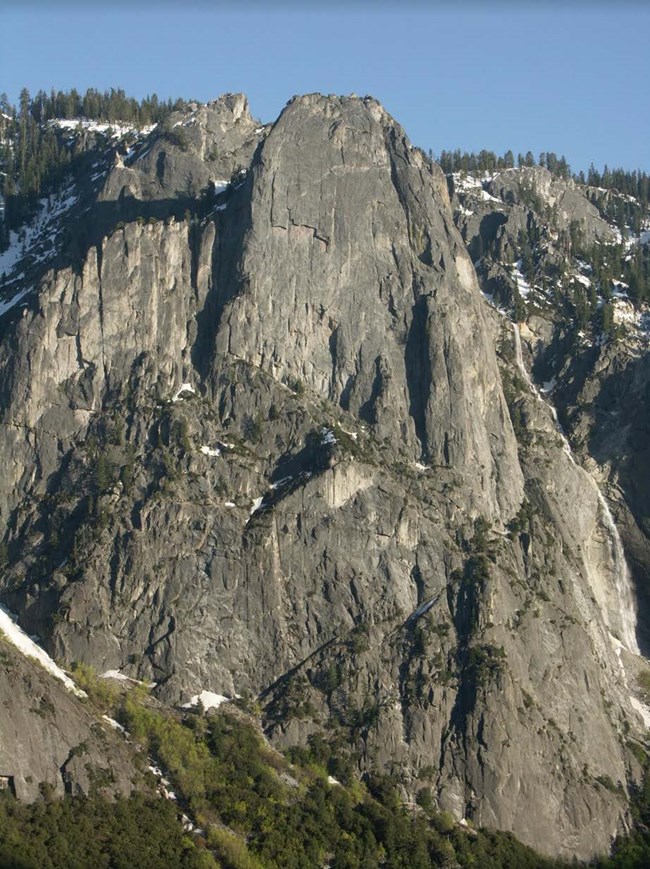
NPS image by Greg Stock.
Ultramafic (those with less silica and more iron and magnesium than mafic rocks) plutonic rocks such as dunite, peridotite, and pyroxenite are found in some national parks like Great Smoky Mountains and Kenai Fjords national parks. Ultramafic volcanic rocks are extremely rare, and are not found in any NPS unit.
Other terms (such as basic, acidic, felsic, etc.) that generally describe the composition of igneous rocks exist, some of which are older terms and have fallen out of use by many American geologists.
Related Links
► Intrusive (Plutonic) Rock Classification
Intrusive rocks are classified on the proportion of major minerals in them, particularly the relative amounts of quartz, alkali-feldspar, and plagioclase. Mafic and intermediate intrusive rocks also have a significant proportion of minerals that contain iron and magnesium such as olivine, pyroxene, amphibole, and biotite. The different types of mafic intrusive rocks are classified on their relative amounts of olivine, pyroxene, and plagioclase.
The minerals found in the three main types of plutonic rocks are:
- Granite consists mostly of quartz and alkali-feldspar, with relatively minor plagioclase feldspar and mafic minerals (biotite, muscovite and/or amphibole [hornblende]).
- Diorite consists mostly of plagioclase feldspar, amphibole, and pyroxene.
- Gabbro consists mostly of pyroxene, olivine, and plagioclase feldspar.
The diagram below shows the classification of intrusive igneous rocks in Blue Ridge Parkway and the some of the different types of intrusive rocks beyond the three main types. Rock types are plotted to show the relative amounts of quartz, alkali feldspar, and plagioclase felspar they contain. Because this diagram doesn’t include mafic minerals (olivine and pyroxene), it can’t be used to differentiate the intermediate diorite from the mafic gabbro.

NPS image by Trista L. Thornberry-Ehrlich (Colorado State University).
Triangular shaped diagram shows where rock composition falls between end members (at each corner): quartz, alkali feldspar, and plagioclase feldspar. From top down (quartz-rich to quartz-poor): quartz-rich granitoids (60-100% quartz), then across the triangle from alkali feldspar granite, leucogranite and syenogranite, granite, monzogranite, granodiorite, and tonalite (all 20-60% quartz). Next row down is quartz alkali feldspar syenite, quartz syenite, quartz monzonite, quartz monzodiorite, quartz diorite and quartz gabbro (all 5-20% quartz). Lowest level with almost no quartz content, from alkali feldspar rich to plagioclase feldspar rich is alkali feldspar syenite, syenite, monzonite, monzodiorite, and diorite gabbro norite. Rocks that appear mapped in Blue Ridge Parkway are syenogranite, granite, monzogranite, granodiorite, quartz monzodiorite, quartz monzonite, monzonite, monzodiorite, diorite, and quartz gabbro.
Orange area refers to compositions of units included in the GRI GIS data for Blue Ridge Parkway. Numbers refer to the percentage of the mineral constituent (quartz, alkali feldspar, or plagioclase feldspar) in the overall composition of the rock. Numbers 5, 20, and 60 refer to the overall quartz component, whereas numbers 10, 35, 65, and 90 refer to the contribution of plagioclase to the overall composition. The corners represent compositions very rich in the corresponding mineral and poor in the two other minerals, but not necessarily other possible component minerals.
NPS image by Trista L. Thornberry-Ehrlich (Colorado State University) following standard International Union of Geological Sciences (IUGS) nomenclature.
► Extrusive (Volcanic) Rock Classification
Volcanic rocks are classified based on their chemical composition as determined by analytical techniques that identify the proportion of major elements found in them. Unlike for plutonic rocks, it is not possible to classify volcanic rocks based on the minerals found in them.
Some volcanic rocks contain some crystals (phenocrysts) that grew in the magma chamber prior to eruption, but others contain no crystals at all or are volcanic glass (obsidian).
In addition to the mafic (low silica) basalt, and the silicic rhyolite, several subdivisions exist between the two compositional end members.

NPS graphic by Allyson C. Mathis.
Additional types of volcanic rocks are classified based on the amount of other elements such as potassium, sodium, or calcium present in the rock. For example, mafic volcanic rocks with high potassium and sodium are known as trachybasalts.
Characteristics and Properties
Mafic and silicic rocks have important differences in their characteristics and properties because their composition controls these variables. Two of the most important are melting temperature and viscosity (resistance to flow). Mafic magmas have high melting temperatures and low viscosity. Silicic ones have lower temperatures and high viscosity.
Composition also determines what minerals are present in igneous rocks. Mafic rocks contain minerals that are high in magnesium and/or iron such as olivine, pyroxene, amphibole, magnetite, as well as plagioclase feldspar. Quartz (SiO2) cannot form in mafic magmas so this mineral is not found in gabbro or basalt. Feldspars and quartz are the most common minerals in silicic rocks, although these rocks may contain minor amounts of mica (biotite or muscovite), amphibole, magnetite, and other minerals.
|
|
Mafic |
Intermediate |
Silicic |
|
Melting Temperature |
High |
Medium |
Low |
|
Viscosity |
Low |
Moderate |
High |
|
Common Minerals |
Olivine, pyroxene, plagioclase feldspar, magnetite |
Plagioclase feldspar, pyroxene, amphibole, magnetite |
Potassium feldspar, quartz, mica, amphibole |
|
Color |
Dark |
Gray or salt-and-pepper |
Light |
Textural and Structural Names
Several terms can be used as modifiers when describing compositional rock types, as in “vesicular basalt” or “porphyritic granite.” But some terms can be used alone when the features are characteristic of a single rock type. For example, most pumice is rhyolitic so the composition for this rock type is usually inferred. Similarly, almost all pegmatite has granitic composition.

NPS photograph by Amanda Lanik.
Rock Descriptors—Definitions and Glossary
Below are some Rock Types, Parts of Rocks, and Other Descriptors that are most likely to be in common usage. There are many other terms that may be in use, in combination or stand alone, to describe a rock's texture and structure.
Rock Types
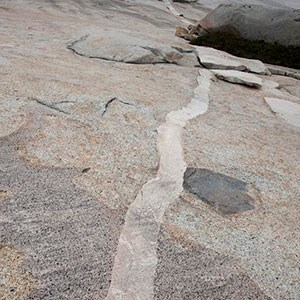
Aplite - A light-colored, fine-grained intrusive igneous rock with sugary texture emplaced at relatively shallow depths beneath Earth’s surface, consisting mostly of feldspar and quartz.
Photo (right): An aplite vein within granitic rock. Yosemite National Park, California.
Photo by Marli Miller on geologypics.com.
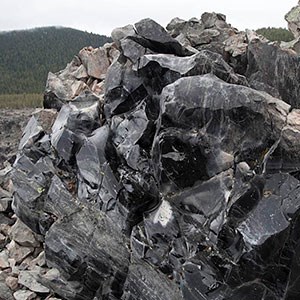
Obsidian - Black or dark-colored volcanic glass, usually of rhyolite composition. Basaltic glass is very rare because basalt devitrifies (converts from glass to crystalline material) easily, whereas rhyolite glass does not.
Photo (right): Big Obsidian Flow, Newberry Volcano. Newberry National Volcanic Monument, Oregon.
Photo by Marli Miller on geologypics.com.
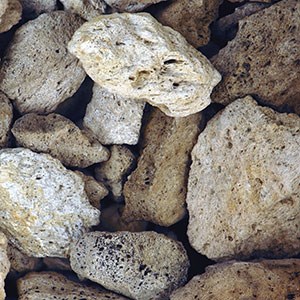
Pumice - A highly vesicular or frothy pyroclastic rock with very low bulk density and thin vesicle walls, usually with rhyolitic composition, formed during some highly explosive eruptions.
Photo (right): Airfall pumice. Medicine Lake Volcano, California.
Photo by James St. John on Flickr.
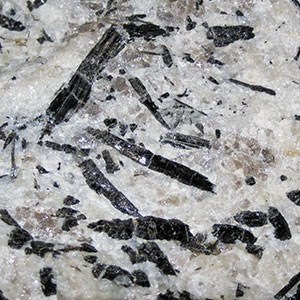
Pegmatite - An intrusive igneous rock, usually of granitic composition, consisting of exceptionally large interlocking crystals. It commonly occurs in irregular dikes, lenses, and veins, especially at the margins of batholiths, but also as plutons—see Intrusive Rock Types, below.
Photo (right): Tourmaline in pegmatitic granite. Crabtree Pegmatite from the Blue Ridge Mountains.
Photo by James St. John on Flickr.
Parts of Rocks
Groundmass - The finer grained and/or glassy material between the large crystals (phenocrysts) in an igneous rock. Most often used when describing porphyritic volcanic rocks but may be applicable for some plutonic rocks. The groundmass of volcanic rocks may consist of tiny microscopic crystals and/or volcanic glass.
Phenocryst - A large crystal in a porphyritic igneous rock. Phenocrysts may be present in some volcanic rocks as well as in intrusive rocks. In volcanic rocks, phenocrysts usually formed in the magma chamber prior to eruption.
Naming Basalt Features—Hawaii Volcanoes Example


Left image
Vesicular Basalt with Olivine, curated collection of Hawaii Volcanoes National Park, Hawaii.
Credit: Photo by James St. John on Flickr.
Right image
Labels added to Vesicular Basalt with Olivine.
Credit: Photo by James St. John on Flickr labeled for the NPS by Allyson C. Mathis
Naming Basalt Features—Haleakalā National Park Example
Other Descriptors
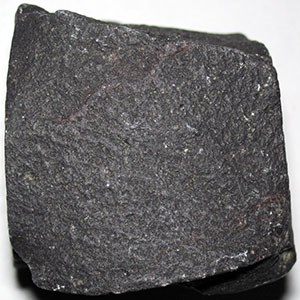
Aphanitic - The texture of fine-grained igneous rock in which different components are not distinguishable by the unaided eye.
Photo (right): Aphantic basalt forms with rapid cooling.
Photo by James St. John on Flickr.
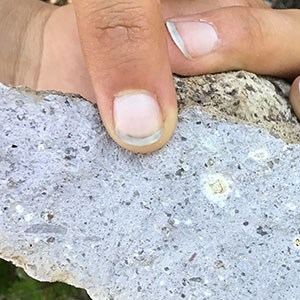
Pyroclastic – The texture of a rock formed of fragmentary particles (pyroclasts) ejected during highly explosive volcanic eruptions. Pyroclastic means “fire-broken.” See also, Pyroclasts and Pyroclastic Rocks (article).
Photo (right): Lava Creek Tuff. Yellowstone National Park, Wyoming, Montana, and Idaho.
USGS YVO photo by Ray Salazar (Montana State University).
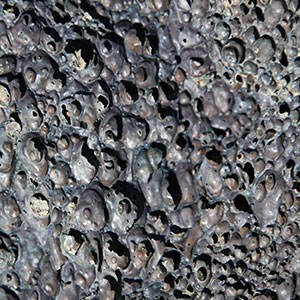
Vesicular - Describes the texture of a rock, especially lava, characterized by abundant vesicles formed as a result of the expansion of gases during the fluid stage of the lava. Pyroclasts such as pumice and scoria also are vesicular.
Photo (right): Close-up of vesicular basalt with many air bubbles (vesicles). Craters of the Moon National Monument and Preserve, Idaho.
NPS photo by James St. John on Flickr.
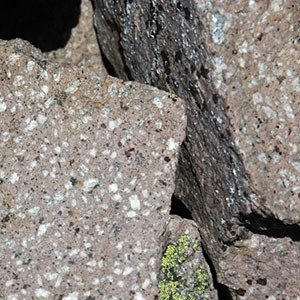
Porphyritic – The texture of an igneous (volcanic or plutonic) rock that contains large crystals (phenocrysts) in a fine-grained groundmass.
Photo (right): Porphyritic rhyodacite, Lassen Volcano National Park, California.
Photo by James St. John on Flickr.
Intrusive Rock Types
Intrusive (plutonic) igneous rocks are found in either large bodies (plutons or batholiths) or are thin sheets that either cut across (dikes) or are parallel (sills) to layering in the surrounding rocks.
Many intrusive bodies result from the solidification of magma chambers that had been underneath volcanoes and then are later exposed by subsequent erosion. The plutonic rocks in Yosemite, Kings Canyon, and Sequoia national parks are all part of the Sierra Nevada Batholith that formed.
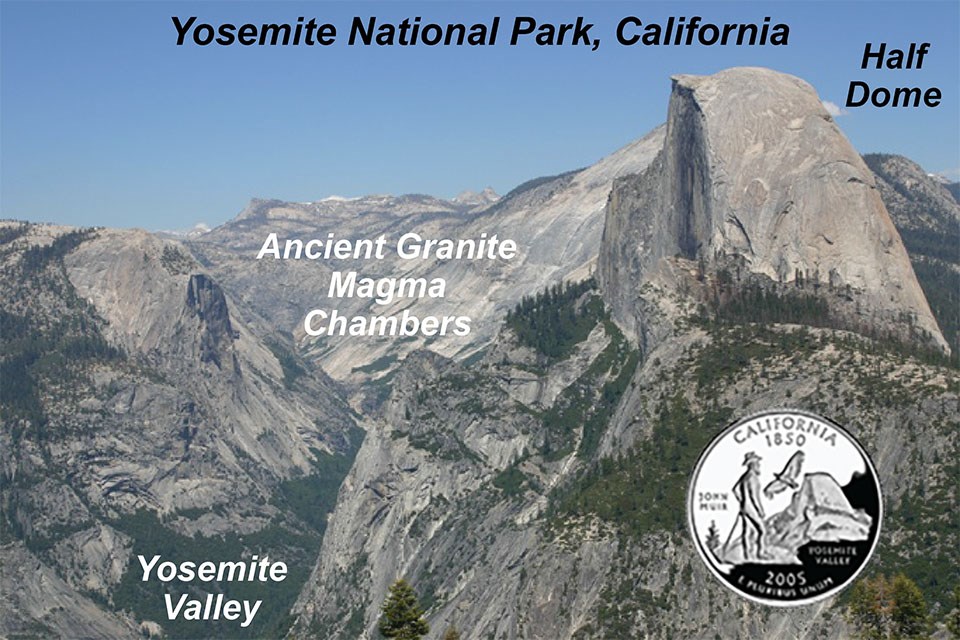
Photo Courtesy of Robert J. Lillie.
Other intrusive rocks, especially mafic ones such as gabbros, are found in ophiolite complexes which are sections of oceanic crust that have been uplifted and emplaced onto continental areas through tectonic processes.
► Gabbro
Gabbros are found in ophiolite complexes and in some batholiths. These rocks usually have a dark color and contain crystals of pyroxene, olivine, and plagioclase feldspar.

NPS photo.
National Parks with Gabbro
-
Acadia National Park, Maine—[Geodiversity Atlas] [Park Home] [npshistory.com]
-
Big Bend National Park, Texas—[Geodiversity Atlas] [Park Home] [npshistory.com]
-
Grand Canyon National Park, Arizona—[Geodiversity Atlas] [Park Home] [npshistory.com]
-
Joshua Tree National Park, California—[Geodiversity Atlas] [Park Home] [npshistory.com]
-
Kenai Fjords National Park, Alaska—[Geodiversity Atlas] [Park Home] [npshistory.com]
-
Yosemite National Park, California—[Geodiversity Atlas] [Park Home] [npshistory.com]
► Diorite
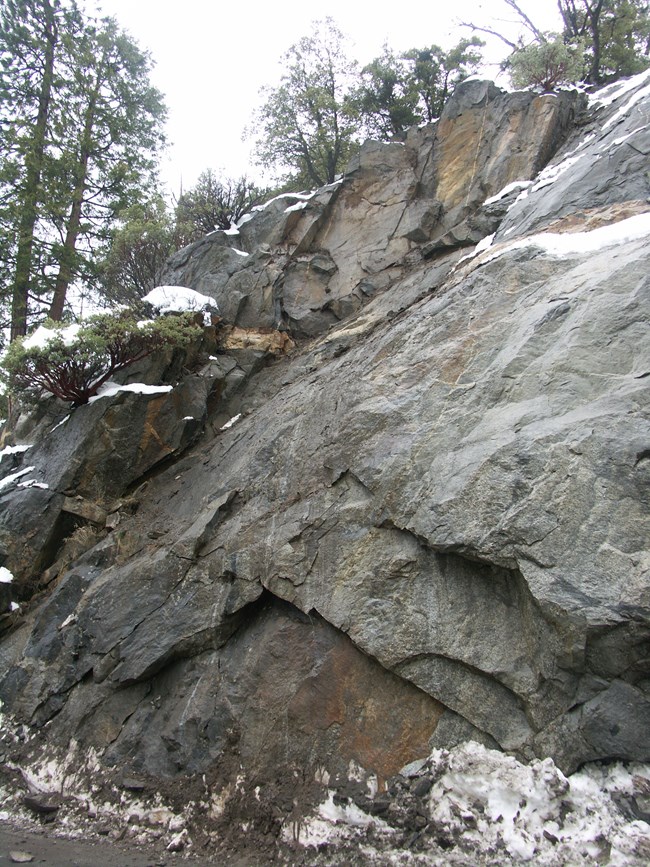
NPS photo.
Diorite has an intermediate composition and commonly has a “salt and pepper” appearance due to nearly equal amounts of light-colored minerals (plagioclase feldspar) and dark-colored minerals (pyroxene and amphibole). Diorite occurs in association with granite in many large plutons and batholiths, such as in the Sierra Nevada Batholith.
National Parks with Diorite
-
Acadia National Park, Maine—[Geodiversity Atlas] [Park Home] [npshistory.com]
-
Grand Canyon National Park, Arizona—[Geodiversity Atlas] [Park Home] [npshistory.com]
-
Kings Canyon National Park, California—[Geodiversity Atlas] [Park Home] [npshistory.com]
-
Joshua Tree National Park, California—[Geodiversity Atlas] [Park Home] [npshistory.com]
-
Sequoia National Park, California—[Geodiversity Atlas] [Park Home] [npshistory.com]
- Yosemite National Park, California—[Geodiversity Atlas] [Park Home] [npshistory.com]
► Granite
Granite is the most common type of intrusive rock in continental crust and is by far the most-well known type of intrusive rock. Granite makes up the bulk of most plutons and batholiths. The granites in Yosemite National Park, Mount Rushmore National Memorial, and Acadia National Park are among the most well-known rocks of any national park site. Ancient Precambrian granites are also found at the bottom of Grand Canyon, and in Black Canyon of the Gunnison National Park, where they occur with metamorphic rocks.
Granite has a silicic composition, and consists predominantly of alkali feldspar and quartz, with some plagioclase feldspar, and a minor amount of mafic minerals (biotite, muscovite, and/or amphibole).
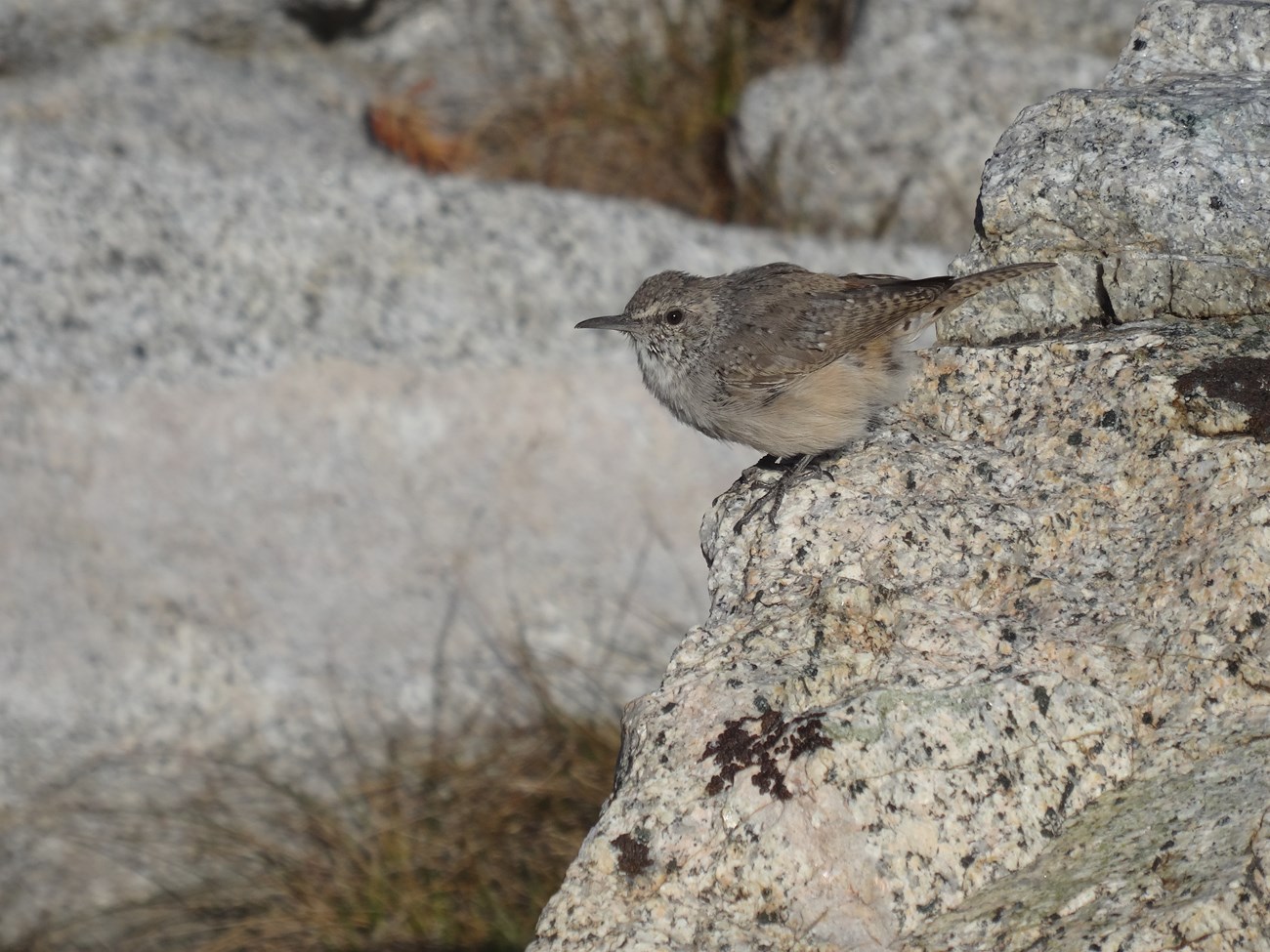
Photographer Mandy Holmgren, The Institute for Bird Populations.
National Parks with Granite
-
Acadia National Park, Maine—[Geodiversity Atlas] [Park Home] [npshistory.com]
-
Bering Land Bridge National Preserve, Alaska—[Geodiversity Atlas] [Park Home] [npshistory.com]
-
Black Canyon of the Gunnison National Monument, Colorado—[Geodiversity Atlas] [Park Home] [npshistory.com]
-
City of Rocks National Reserve, Idaho—[Geodiversity Atlas] [Park Home] [npshistory.com]
-
Grand Canyon National Park, Arizona—[Geodiversity Atlas] [Park Home] [npshistory.com]
-
Grand Teton National Park, Wyoming—[Geodiversity Atlas] [Park Home] [npshistory.com]
-
Kings Canyon National Park, California—[Geodiversity Atlas] [Park Home] [npshistory.com]
-
Joshua Tree National Park, California—[Geodiversity Atlas] [Park Home] [npshistory.com]
-
Mount Rushmore National Memorial—[Geodiversity Atlas] [Park Home] [npshistory.com]
-
Rocky Mountain National Park, Colorado—[Geodiversity Atlas] [Park Home] [npshistory.com]
-
Sequoia National Park, California—[Geodiversity Atlas] [Park Home] [npshistory.com]
-
Yosemite National Park, California—[Geodiversity Atlas] [Park Home] [npshistory.com]
Volcanic Rock Types
Volcanic rocks are found in at least 89 different units of the National Park System. Volcanic rocks result from volcanic eruptions and include lava flows, pyroclastic rocks, and deposits produced by other volcanic processes such as lahars and landslides.
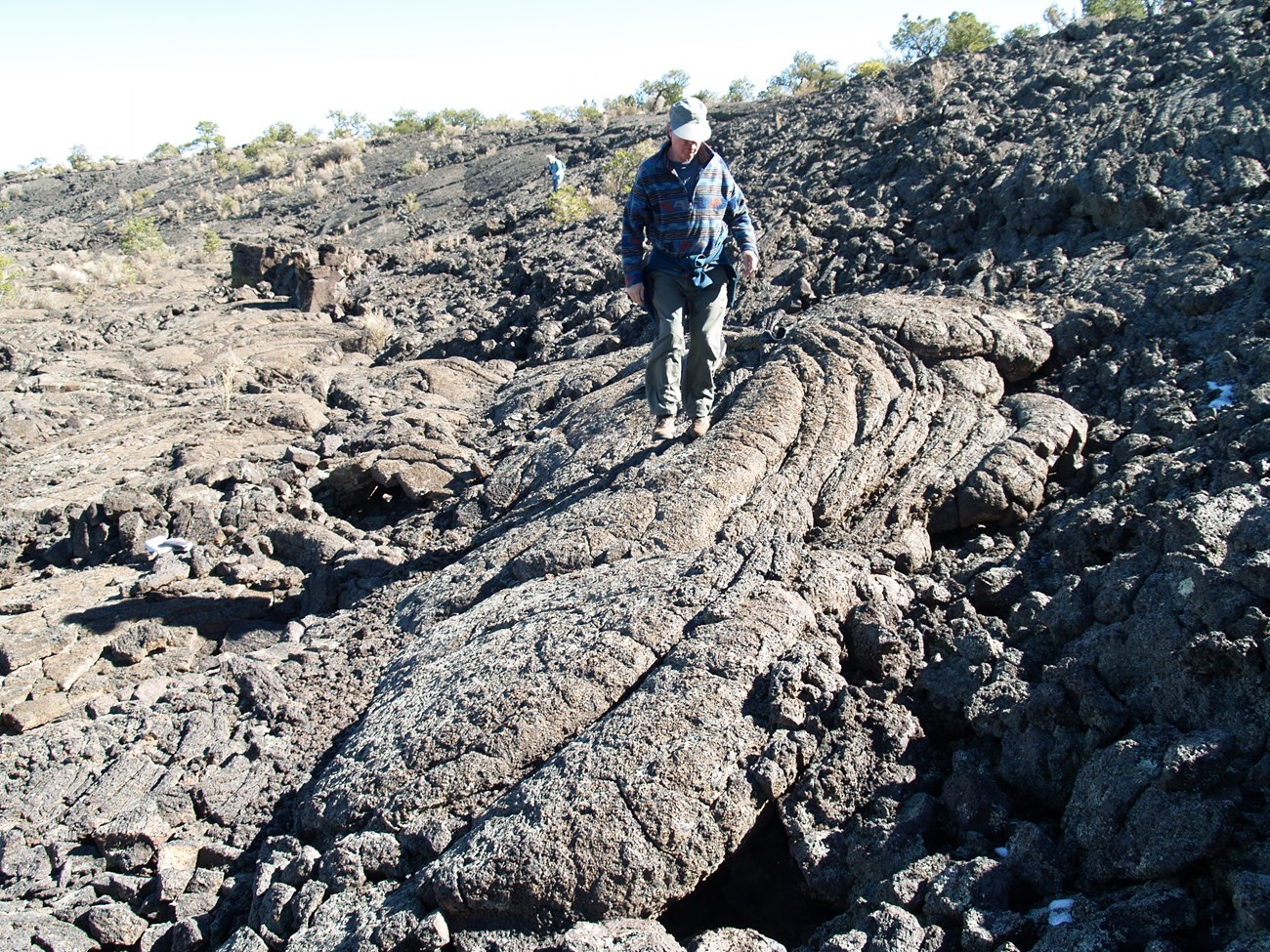
Photo courtesy of Larry Crumpler.
► Basalt
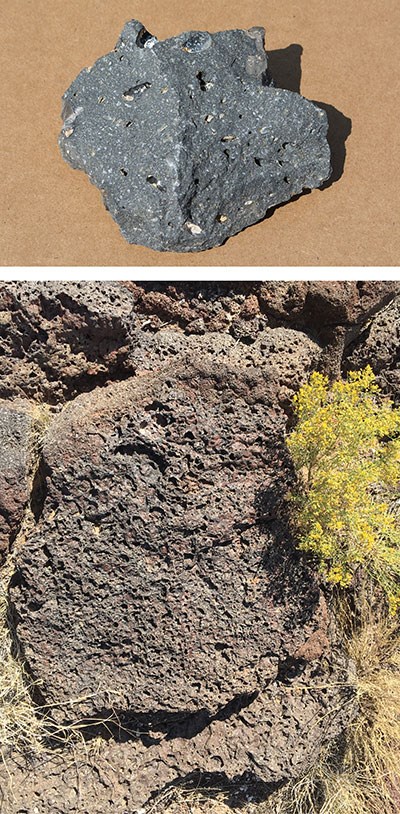
NPS photo by by Chanteil Walter (Petroglyph National Monument).
Basalt is the most common type of volcanic rock found on Earth. It is typically dark in color and is commonly vesicular, and has either an aphanitic or porphyritic texture. Basalt most often occurs as lava flows that travel great distances or as lava pillows formed in subaqueous eruptions. Scoria and cinders also usually have basaltic compositions. Most shield volcanoes are made up of basaltic lavas and most cinder cones are formed during mildly explosive eruptions of basaltic compositions. Basaltic magmas also may be erupted during phreatomagmatic (hydrovolcanic) eruptions that form maars and tuff rings.
-
Composition: Mafic. 45-52 wt% SiO2
-
Viscosity: Low
-
Main Minerals: Plagioclase feldspar, pyroxene, and olivine
-
Eruption Types: Effusive, Severe, and sometimes Explosive (VEI 0-2): Hawaiian, Strombolian.
-
Volcano Types: Shield Volcanoes, Cinder Cones, Fissure Volcanoes, Monogenetic Volcanic Fields, Maars and Tuff Rings, Composite Volcanoes.
National Parks with Basalt
-
Bering Land Bridge National Preserve, Alaska—[Geodiversity Atlas] [Park Home] [npshistory.com]
-
Capulin Volcano National Monument, New Mexico—[Geodiversity Atlas] [Park Home ] [npshistory.com]
-
Craters of the Moon National Monument, Idaho—[Geodiversity Atlas] [Park Home] [npshistory.com]
-
Death Valley National Park, California & Nevada—[Geodiversity Atlas] [Park Home] [npshistory.com]
-
Devils Postpile National Monument, California—[Geodiversity Atlas] [Park Home] [npshistory.com]
-
El Malpais National Monument, New Mexico—[Geodiversity Atlas] [Volcanic Resources Summary] [Park Home] [npshistory.com]
-
Grand Canyon National Park, Arizona—[Geodiversity Atlas] [Park Home] [npshistory.com]
-
Grand Canyon-Parashant National Monument, Arizona—[Geodiversity Atlas] [Park Home] [npshistory.com]
-
Haleakalā National Park, Hawaii—[Geodiversity Atlas] [Park Home] [npshistory.com]
-
Hawai’i Volcanoes National Park, Hawai’i—[Geodiversity Atlas] [Park Home] [npshistory.com]
-
Isle Royale National Park, Michigan—[Geodiversity Atlas] [Park Home] [npshistory.com]
-
Kalaupapa National Historical Park, Hawai’i—[Geodiversity Atlas] [Park Home] [npshistory.com]
-
Kaloko-Honokohau National Historical Park, Hawai'i—[Geodiversity Atlas] [Park Home] [npshistory.com]
-
Keweenaw National Historic Park, Michigan—[Geodiversity Atlas] [Park Home] [npshistory.com]
-
Lake Mead National Recreation Area, Arizona and Nevada—[Geodiversity Atlas] [Park Home] [npshistory.com]
-
Lake Roosevelt National Recreation Area, Washington—[Geodiversity Atlas] [Park Home] [npshistory.com]
-
Lava Beds National Monument, California—[Geodiversity Atlas] [Park Home] [npshistory.com]
-
Petroglyph National Monument, New Mexico—[Geodiversity Atlas] [Park Home] [npshistory.com]
-
Pu'uhonau o Honaunau National Historic Park, Hawai'i—[Geodiversity Atlas] [Park Home] [npshistory.com]
-
Pu'ukohola Heiau National Historic Site, Hawai'i—[Geodiversity Atlas] [Park Home] [npshistory.com]
-
Saint Croix National Scenic Riverway, Wisconsin and Minnesota—[Geodiversity Atlas] [Park Home] [npshistory.com]
-
Shenandoah National Park, Virginia—[Geodiversity Atlas] [Park Home] [npshistory.com]
-
Sunset Crater Volcano National Monument, Arizona—[Geodiversity Atlas] [Park Home] [npshistory.com]
-
Voyageurs National Park, Minnesota—[Geodiversity Atlas] [Park Home] [npshistory.com]
-
Yellowstone National Park, Wyoming—[Geodiversity Atlas] [Park Home] [npshistory.com]
► Andesite
Andesite and other intermediate lavas are one of the main components of composite volcanoes. Andesitic lavas can sometimes travel great distances, but they make thicker flows than basalt. Many of the lahar deposits associated with composite volcanoes have andesitic composition.
-
Composition: Intermediate. 52–63 wt% SiO2
-
Viscosity: Intermediate
-
Main Minerals: Plagioclase feldspar, pyroxene, and amphibole
-
Eruption Types: Effusive, Severe, Explosive, and Catastrophic (VEI 0-3): Strombolian, Vulcanian.
-
Volcano Types: Composite Volcanoes, Shield Volcanoes.
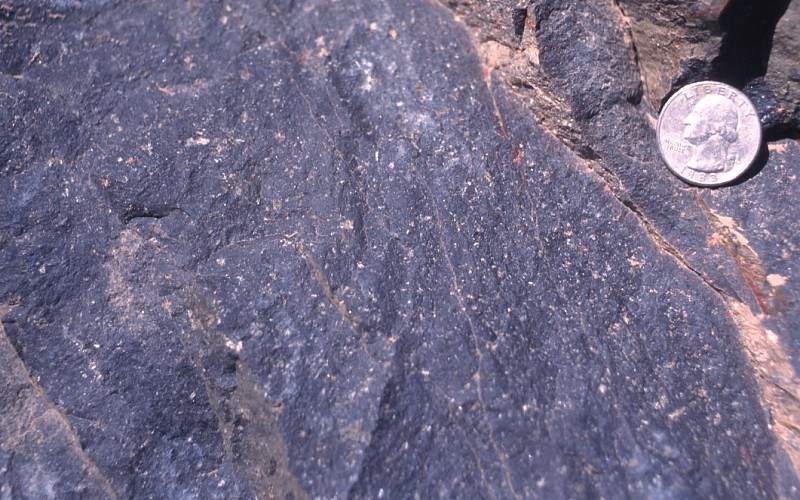
National Park, California.
USGS photo.
National Parks with Andesite
-
Aniakchak National Monument, Alaska—[Geodiversity Atlas] [Park Home] [npshistory.com]
-
Big Bend National Park, Texas—[Geodiversity Atlas] [Park Home] [npshistory.com]
-
Crater Lake National Park, Oregon—[Geodiversity Atlas] [Park Home] [npshistory.com]
-
John Day Fossil Beds National Monument, Oregon—[Geodiversity Atlas] [Park Home] [npshistory.com]
-
Katmai National Park, Alaska—[Geodiversity Atlas] [Park Home] [npshistory.com]
-
Lake Clark National Park and Preserve, Alaska—[Geodiversity Atlas] [Park Home] [npshistory.com]
-
Lassen Volcanic National Park, California—[Geodiversity Atlas] [Park Home] [npshistory.com]
-
Mount Rainier National Park, Washington—[Geodiversity Atlas] [Park Home] [npshistory.com]
-
Organ Pipe Cactus National Monument, Arizona—[Geodiversity Atlas] [Park Home] [npshistory.com]
-
Pinnacles National Monument, California—[Geodiversity Atlas] [Park Home] [npshistory.com]
-
Saguaro National Park, Arizona—[Geodiversity Atlas] [Park Home] [npshistory.com]
-
Wrangell-St. Elias National Park and Preserve, Alaska—[Geodiversity Atlas] [Park Home] [npshistory.com]
- Yellowstone National Park, Wyoming—[Geodiversity Atlas] [Park Home] [npshistory.com]
► Dacite
Dacites are found in lava domes and in composite volcanoes. Some highly explosive eruptions that form pyroclastic flows are of dacitic composition. Dacitic lava flows are very short and stubby, and dacitic domes are common.
-
Composition: Silicic: 63–69 wt% SiO2
-
Viscosity: High
-
Main Minerals: Plagioclase feldspar, quartz, and amphibole
-
Eruption Types: Effusive (for lava domes) (VEI 0), Cataclysmic to Mega-colossal (VEI 4-7): Sub-Plinian, Plinian.
-
Volcano Types: Lava Domes, Composite Volcanoes
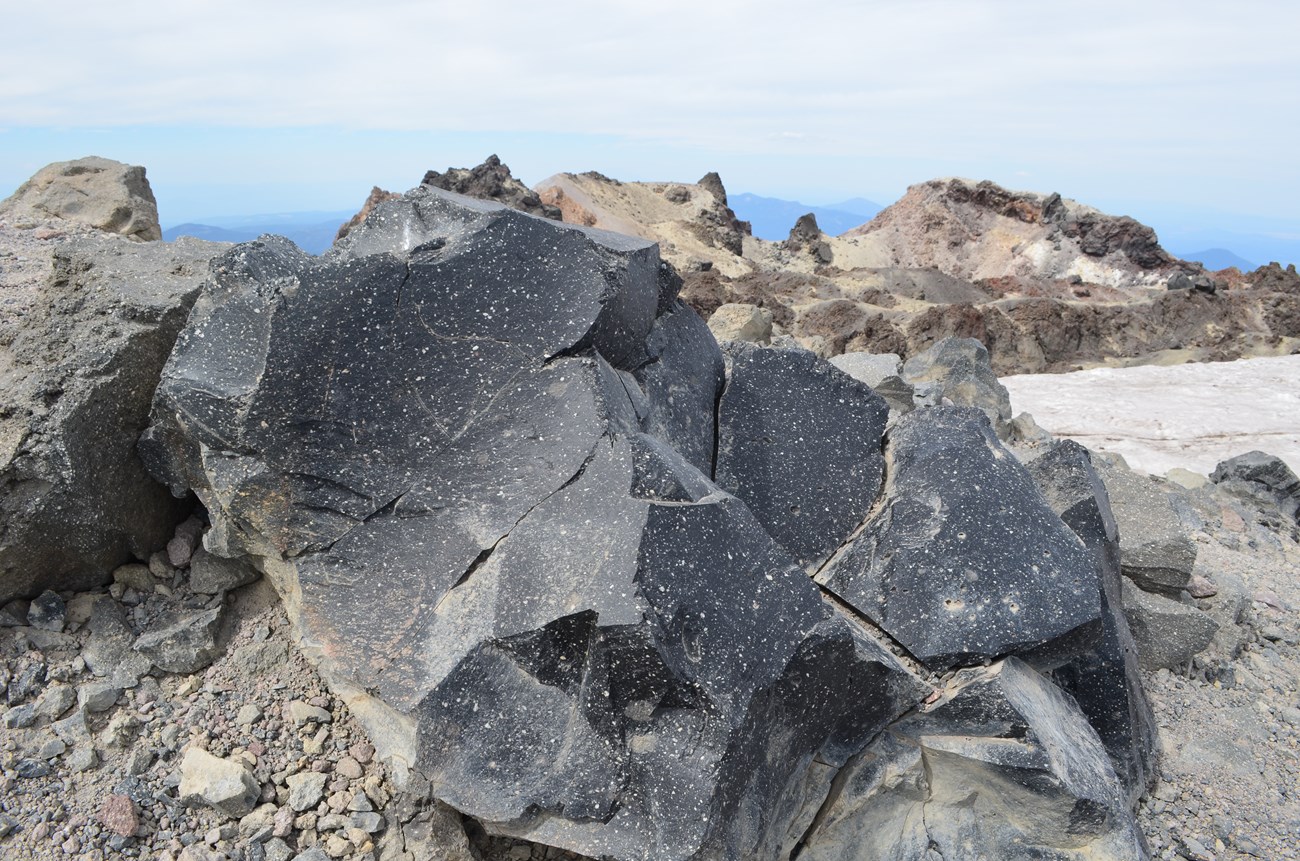
NPS photo.
National Parks with Dacite
-
Aniakchak National Monument, Alaska—[Geodiversity Atlas] [Park Home] [npshistory.com]
-
Bandelier National Monument, New Mexico—[Geodiversity Atlas] [Park Home] [npshistory.com]
-
Crater Lake National Park, Oregon—[Geodiversity Atlas] [Park Home] [npshistory.com]
-
Great Basin National Park, Nevada—[Geodiversity Atlas] [Park Home] [npshistory.com]
-
Katmai National Park, Alaska—[Geodiversity Atlas] [Park Home] [npshistory.com]
-
Lake Clark National Park and Preserve, Alaska—[Geodiversity Atlas] [Park Home] [npshistory.com]
-
Lassen Volcanic National Park, California—[Geodiversity Atlas] [Park Home] [npshistory.com]
-
Mount Rainier National Park, Washington—[Geodiversity Atlas] [Park Home] [npshistory.com]
-
Organ Pipe Cactus National Monument, Arizona—[Geodiversity Atlas] [Park Home] [npshistory.com]
-
Pinnacles National Monument, California—[Geodiversity Atlas] [Park Home] [npshistory.com]
-
Saguaro National Park, Arizona—[Geodiversity Atlas] [Park Home] [npshistory.com]
- Valles Caldera National Preserve, New Mexico—[Geodiversity Atlas] [Park Home] [npshistory.com]
► Rhyolite
Rhyolite may be found in lava domes or even lava flows, but most often in pyroclastic deposits formed either through ash-flow or ash-fall. Large-volume rhyolitic lava flows are known from the Yellowstone National Park region and in and around Fort Davis National Historic Site in the Davis Mountains of Texas. Rhyolitic obsidians may be found in some lava flows or domes. Some of the largest eruptions by volume and the most explosive eruptions are of rhyolitic magmas, especially at resurgent calderas like at Yellowstone or Valles Caldera National Preserve where thick ignimbrites (pyroclastic flow deposits) are found.
-
Composition: Low silica: >72 wt% SiO2
-
Viscosity: Very high
-
Main Minerals: Alkali feldspar, quartz, plagioclase feldspar, and amphibole or mica (muscovite or biotite
-
Eruption Types: Effusive (for lava domes) (VEI 0), Colossal to Apocalyptic (VEI 6-8): Plinian, Utra-Plinian.
-
Volcano Types: Composite Volcanoes, Lava Domes, Explosive Calderas (Resurgent and Summit Calderas)

Photo by James St. John on Flickr.
National Parks with Rhyolite
-
Aniakchak National Monument, Alaska—[Geodiversity Atlas] [Park Home] [npshistory.com]
-
Bandelier National Monument, New Mexico—[Geodiversity Atlas] [Park Home] [npshistory.com]
-
Big Bend National Park, Texas—[Geodiversity Atlas] [Park Home] [npshistory.com]
-
Chiricahua National Monument, Arizona—[Geodiversity Atlas] [Park Home] [npshistory.com]
-
Coronado National Monument, Arizona—[Geodiversity Atlas] [Park Home] [npshistory.com]
-
Crater Lake National Park, Oregon—[Geodiversity Atlas] [Park Home] [npshistory.com]
-
Fort Davis National Historic Site, Texas—[Geodiversity Atlas] [Park Home] [npshistory.com]
-
Gila Cliff Dwellings National Monument, New Mexico—[Geodiversity Atlas] [Park Home] [npshistory.com]
-
John Day Fossil Beds National Monument, Oregon—[Geodiversity Atlas] [Park Home] [npshistory.com]
-
Katmai National Park, Alaska—[Geodiversity Atlas] [Park Home] [npshistory.com]
-
Lake Clark National Park and Preserve, Alaska—[Geodiversity Atlas] [Park Home] [npshistory.com]
-
Organ Pipe Cactus National Monument, Arizona—[Geodiversity Atlas] [Park Home] [npshistory.com]
-
Saguaro National Park, Arizona—[Geodiversity Atlas] [Park Home] [npshistory.com]
-
Valles Caldera National Preserve, New Mexico—[Geodiversity Atlas] [Park Home] [npshistory.com]
-
Yellowstone National Park, Wyoming—[Geodiversity Atlas] [Park Home] [npshistory.com]
Last updated: November 8, 2023


